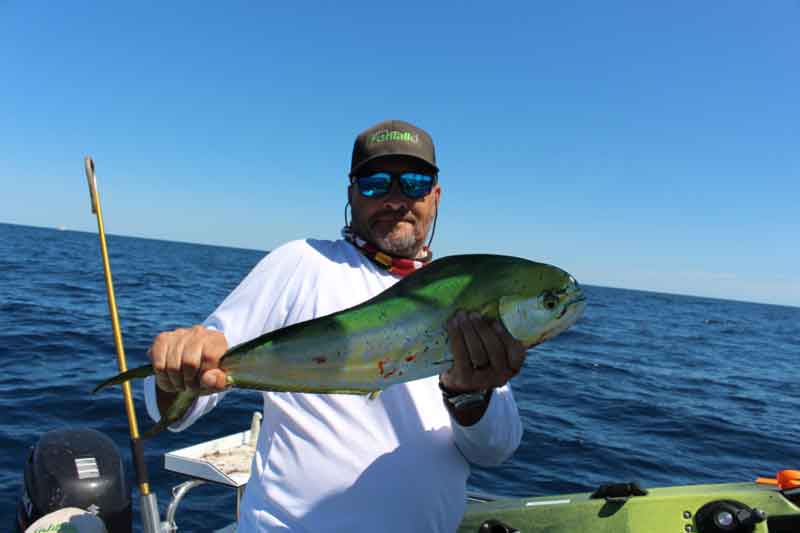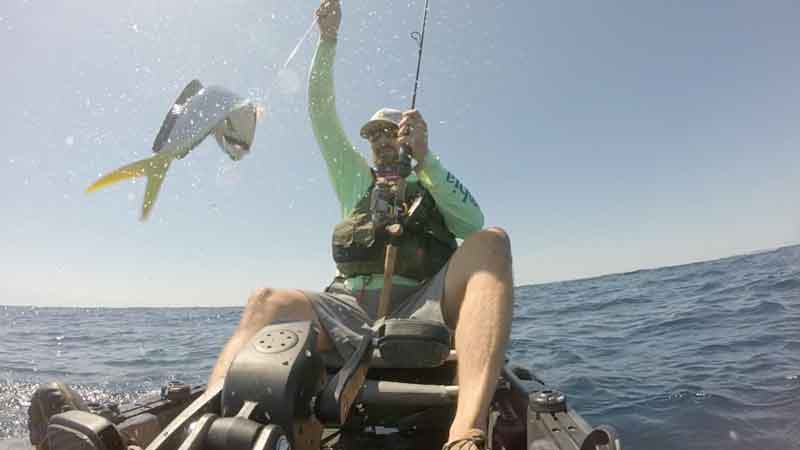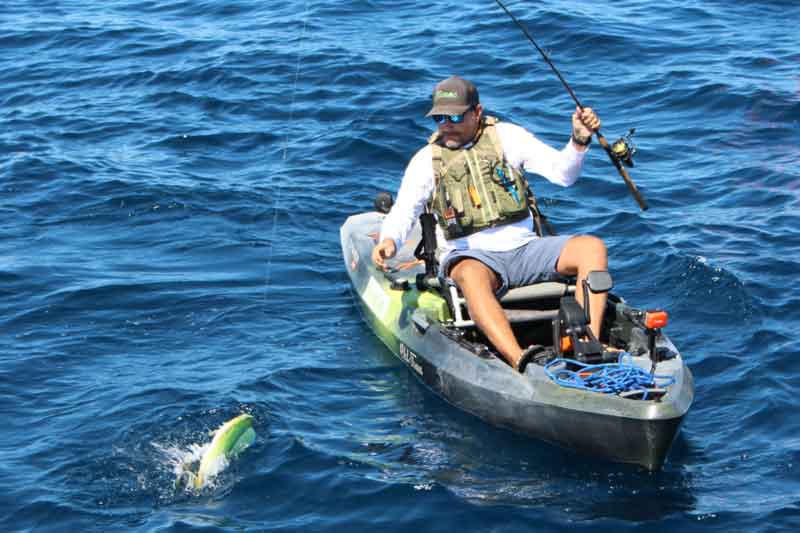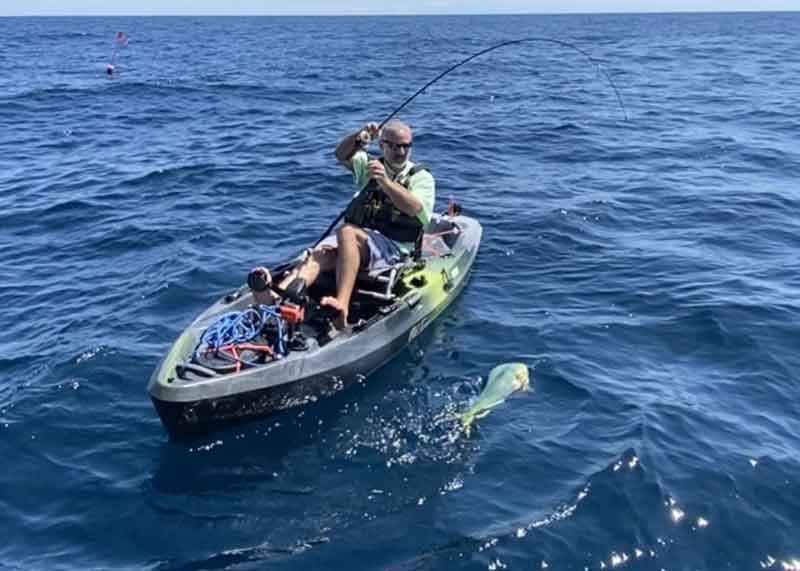It’s late in the ninth month of 2020, which shall undoubtedly go down in history as the Worst Year Ever. Laugh at this, dear friends, because the sharpest mental arrow in our anti-Covid quiver is a good sense of humor. And it gets worse. On top of the steady stream of bad news, a social fabric being torn so viciously that you can almost hear it ripping, and fears of infection constantly scaring the fertilizer out of me, I feel like I’m in a fishing rut. While I’m grateful to still be able to wet a line whenever I please, at this point I’ve eaten so much rockfish, white perch, Spanish mackerel, and bluefish that I’m wondering if it’s possible to O.D. on Omega-3. The arrival of cobia in the Chesapeake presented a welcome distraction from chasing the same-same species for a while, but at this point in the season even going after those Lower Bay brutes seems a bit hum drum.
It’s time for Adventure Fishing.
Just what is Adventure Fishing? The answer depends entirely upon what captivates your imagination. Maybe you’d like to try flying shark bait off the beach with a drone, or maybe you’d like to be the drone and try fishing from a hang glider. Whatever. In normal times many people decide to fly to a distant destination where they’ll chase exotic species like bonefish or tarpon. Except, of course, that in the age of Covid the flying part has become a bit of a stickler. In any case, to qualify as a true adventure it has to be a completely new experience, require advanced planning and unusual effort, and involve at least some tiny element of danger.
Flash back to the summer of 2019. We’re 30 miles east of Ocean City, bailing for mahi-mahi around patches of sea bass trap floats. It’s an adventure in the sense that nearly every fishing trip is; you never know what will bite your hook, how big it will be, or what will happen next. We’ve been surprised by surfacing sea turtles, porpoises playing in our wake, and feisty almaco jack mixed in with the mahi. But we’ve done this type of fishing many times before. It’s an adventure, but it falls short of Adventure Fishing status. Then one of the guys aboard, FishTalk contributor Eric Packard, gets a funny grin on his face and says “you know, it would be really exciting to catch these fish from a kayak.”
Indeed.
Almost exactly one (awful, horrible, very bad no good) year later, there’s an ideal weather-window. The mahi are within shooting distance. And we are all itching for some adventure in our lives.
Both Eric and FishTalk Production Manager Zach Ditmars are experienced yak anglers and I’m not, so I leave all the details relating to the kayak to them. With a fleet of five to choose from, they decide on Zach’s Old Town Topwater PDL because it has a pedal drive for hands-free fish-fighting, but should be relatively easy to launch and retrieve from our 22 Glacier Bay “mothership” since it’s compact at 10’6” and weighs under 100 pounds.
Saturday afternoon arrives. I prep the big boat, Zach preps the Old Town, Eric preps the food and drinks, and all of us attempt to go to sleep early even though we know it will be a fitful night of tossing and turning. It always is, when you’ll be getting up at zero-dark-early to embark upon an Adventure Fishing trip. All seriously addicted anglers know this drill:
- 9:00 p.m. – Lay out your clothes for the morning, in your final pre-fishing preparation ritual. Turn off the lights, and get into bed. Run through the list of all the things you need to have ready, in your mind. Reassure yourself that yes, you’ve checked all the boxes.
- 9:05 to 9:50 p.m. – Envision all the things that could go wrong: a flat tire while trailering to the inlet; one of the outboards won’t start; the batteries are dead; the fishfinder/chartplotter is fried; you make it all the way offshore and are confronted with the aggravatingly common you-shoulda-been-here-yesterday kind of bite. Then finally, mercifully, you begin to drift off and…
- 9:51 p.m. – Sit bolt upright as your slumber-fogged brain somehow realizes that you left the spool of 30-pound fluoro sitting on your desk after rigging up the rods. You might remember to grab it in the morning but you might not, which means you need to get up and put it in the boat right now. You put on your robe, stumble down the stairs, grab the leader, walk out into the chilly night air, and climb into the boat. You open your leader box and as you drop in the spool, glance down to see the other spool of 30 that you forgot you’d bought at the tackle shop yesterday.
- 10:25 p.m. – You’re still not asleep, but at least your heart rate has returned to normal at this point. Then you feel a tickle in your nose and sneeze OHMYGODDOIHAVECOVID!?!?!
- 12:45 a.m. – Your teenage son slams his bedroom door, waking you up.
- 12:46 a.m. – Your teenage daughter slams the bathroom door, waking you up.
- 12:48 a.m. – Your teenage son and daughter get into an argument about slamming doors, keeping you awake for the next 20 minutes.
- 2:00 a.m. – The alarm clock starts shriek-beeping.
Mercifully, our drive to the boat ramp is completely uneventful. There we splash the boat, load the kayak into it, and pull off the dock to try an experimental launch and retrieve in the sheltered waters. Satisfied it’s doable, we strap the kayak down and idle towards the inlet. On the way Zach wins a coin-toss to see who will get the first turn in the yak. As we pass beyond the inlet rocks, we go through another experience that all die-hard fishers are familiar with: your first look around to assess just how horribly wrong the marine weather forecast has been.
We gaze out over the horizon. We look east, we look south, we look north, and we are amazed. We then look at each other in shock — the weatherman was right. The waves are one to two feet with a 12 second period; the ocean is essentially glass.
Twenty-some miles later, I pull back the throttles. There are a dozen bass trap floats off the port bow but we have a problem, because there are also two dozen boats trolling around them. Word must have gotten out about this bite. Dang those weekly FishTalk fishing reports! Whether we can catch fish here or not, we decide it’s too risky to launch the kayak with this many boats milling around and opt to keep running. At 34 miles we find a field of floats that has just a pair of boats working it. We pull up to the first float and toss some chunks, then baits. No takers. We try another. And another. We hook into a few loner mahi and Zach pulls in a nice 10-pounder, but we don’t find the school we’re looking for. We begin running again.

Mid-morning we stop heading east and turn south. At noon we make a depressing turn to the west. Every pot we’ve hit has zero to one fish on it and the school we’re in search of remains elusive. We’ve had fun and boated a few mahi, but our adventure is turning into little more than a slow day of normal fishing. Fewer words are now being spoken. Laughs become harder to produce. We discuss the flounder bite, and begin to wonder aloud if we should drift the Great Eastern reef on the way home and at least try to pick up a few flounder for a change of pace.
Just inside 30 miles from the inlet, we spot another set of floats. There are a few boats trolling the area, and we know it’s been picked over at this late point in the day. But an angler’s most effective tool is persistence — we will give it a shot. I pull back the throttles, and we bail a float. Deserted. The next float and the one after that are also devoid of life. There’s one more on a direct path to the Great Eastern, and we’re still 30 yards away from it when Zach starts shouting.
As I shift into neutral he grabs a baited rod, tosses the squid chunk over the side, and immediately hooks up. But as he pulls the mahi towards the boat, we don’t just see the one fish. We see 30, maybe 40, swirling around beneath it. The fish on the line suddenly loses all importance. Our hope for success had faded to a dim glimmer, the same way it does when you realize you’re casting in the dark after trying for a sunset topwater bite. But now we have a very real shot at our goal.
Zach horses the fish in, swings it over the gunwale, and leaves it kicking on the deck as he joins Eric in removing the straps on the kayak. They each grab an end, swing it over the side, and in a fumbling, cursing minute that takes about an hour to wait through, they install the seat and peddle drive. We toss squid chunks over the side to keep the mahi close as Zach secures his life vest and climbs from the big boat into the little one. He begins peddling and gets about three feet away when he suddenly reverses direction, calling to Eric for help — we forgot to unstrap the rudder, and he can’t do it from inside the kayak. Then finally, we have all the pieces in place and I’m watching Zach through the viewfinder of my camera as he glides away from the Glacier Bay, and out into the open Atlantic.
In moments, he’s hooked up. It’s a small fish but an honest-to-goodness pelagic creature of the wild. Zach fights it up, swings it into the kayak, and heads back to us as the fish slaps at his pedaling knees. Eric and Zach trade places and I toss more chunks over the side. The fish are now in a full-blown frenzy, swirling in a feeding vortex every time a handful of chum hits the water. Eric’s rod goes down moments after casting his bait and soon he’s sharing his very limited cockpit space with a flip-flopping mahi-mahi of his own. The two of them take turns in the kayak, giggling like six-year-olds as they go for fish-powered sleighrides and swing mahi after mahi over the six-inch gunwales.

I decide that it’s time for this old dog to learn some new tricks, put down the camera, and when Eric returns with his latest fish I climb into the kayak myself.

I hear the ocean lapping under the hull as waves now have a different effect on my body, and my brain copes with the need to maintain a different sort of balance while sitting on a 10-foot long, three-foot-wide polyethylene platform bobbing 120 feet above the seafloor. It’s an unfamiliar position in an alien environment, but two casts later I forget all about it when I hook up to 36 inches of electric-yellow-blue-green oceanic fury. I taste the tinge of adrenaline as the fish leaps into the air a mere 15 feet off the bow of the kayak and rips its head back and forth at 5000 rpm, flinging a mixed spray of saltwater and fish slime across my face. I realize that for the first time in my life a fish on the end of my line is jumping and I’m looking up at it.
The kayak begins sliding sideways, I adjust position, and the next thing I know the fish is behind me. Then it’s under me, then it’s jumping in front of me again and I’m pretty dang sure I’m not pedaling, but the kayak is making two or three knots through the water.
“What do I do?!” I call out.
“Catch the fish,” I hear yelled from afar.

And that’s what I do, at least in a manner of speaking. I can’t get the fish into the kayak but I do manage to pedal back to the boat, where Eric is waiting with a landing net. I get the fish within range, Eric makes a well-timed scoop, and we declare victory.
After pulling a dozen mahi out of the school, the fish finally got wise and quit biting. No matter. We had our adventure. We experienced something that few anglers ever will, while fishing the Mid-Atlantic’s waters. And for 14 hours Covid simply ceased to exist. The social fabric of America was intact, political strife was as rare as roosterfish in a reservoir, and during this short window of time the year 2020 didn’t suck. There was nothing on Planet Earth except for us, the kayak, and the fish. And that, dear friends, is what Adventure Fishing is all about.